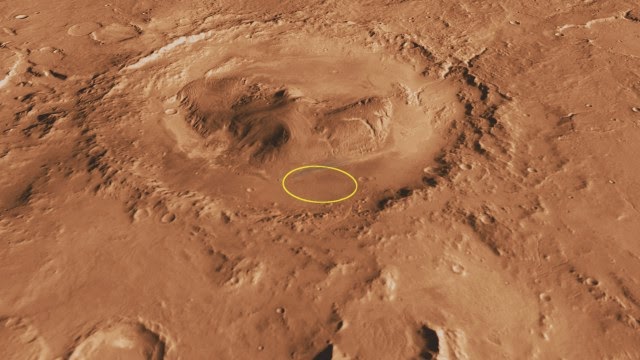| Online: | |
| Visits: | |
| Stories: |

| Story Views | |
| Now: | |
| Last Hour: | |
| Last 24 Hours: | |
| Total: | |
Curiosity samples methane surges in Martian atmosphere
Musings On The Finite Statist Machine
 |
||||||
| Gale Crater viewed from the south, with Curiosity’s landing area highlighted. Methane appears to be coming from somewhere to the north. |
Curiosity samples methane surges in Martian atmosphere
Point to a dynamic and local process—possibly biological—that’s releasing the gas.
by John Timmer – Dec 17 2014, 6:26pm WET
NASA/JPL
On Earth, the majority of the methane that finds its way into the atmosphere is produced by microbes. Once in the atmosphere, the gas is broken down by a number of processes, so its continued presence there is a testimony to Earth’s activity, both biological and geological.
Mars’ atmosphere breaks down methane as well, but there are also low levels of methane in its atmosphere. Although this methane could come from sources that don’t involve biological or geological activity, some Earth-based observations had suggested that Mars had localized sources that create plumes of methane in its atmosphere. Those are tougher to explain, but the observations have been difficult to replicate.
Now, the Curiosity rover has settled the issue, observing spikes in the atmosphere’s methane concentration that seem to indicate a sporadic, local source.
Further Reading
Mars makes methane: sign of life or geology at work?
Today, NASA is announcing the results of a multi-year telescope survey of the …
Various measurements of Mars’ atmosphere have placed methane concentrations at roughly between five and 15 parts per billion. There are a number of potentially mundane sources for this methane, from the breakdown of organic chemicals delivered by small comets and asteroids to the reaction between some minerals and water. But those processes don’t really explain the apparent observations of plumes of more concentrated methane in the atmosphere, which reach levels over three times the normal background before mixing into the atmosphere.
The observations of these large-scale plumes, however, have been hard to replicate. That isn’t entirely a surprise—as they’re necessarily transient events—but it has left some questioning whether they actually existed.
Curiosity was equipped with hardware to sample the atmosphere and measure the amount of methane present. In its initial scans, however, methane levels were exceedingly low, at below five parts per billion. Now, with multiple measurements at different sites in the crater, the researchers running the sampling equipment have concluded that the local background levels are about 0.7 parts per billion—well below previous measurements. But they also found that the levels were not constant.
Somewhere around sol 306 (a sol is a day on Mars), levels shot up to about five parts per billion. A Martian week later, they had dropped down to about two parts per billion—much closer to background levels. The next times measurements were made, on sol 466, methane levels were over five parts per billion again, and they stayed there or higher through to sol 526. By sol 573, the levels had returned to background levels, and they’ve stayed there through to the last measurements included in the new paper, on sol 684.
Methane should mix rapidly with the rest of the Martian atmosphere, so the sudden surges suggest that the source of this methane is both local and focused. Based on the wind direction, the most likely site for the methane source is to the north of the rover’s location. There are no correlations between the presence of high levels of methane and any of the following: relative humidity, atmospheric pressure, temperature, or radiation levels.
The low levels of background methane are roughly in line with predictions of the amount of the gas that should be generated by a UV-driven breakdown of organic material delivered by impacts. Mars is expected to get enough material through this route to fuel a constant concentration of 2.2 parts per billion, although that’s likely to be an upper limit. But impacts are unlikely to produce the sort of localized surges in concentration seen by Curiosity; the breakdown is too slow, and the amount of material required should have produced an obvious impact crater near the rover. (The authors estimate that the crater would be tens of meters wide.)
So while the background can be explained by impacts, the surges in methane concentration can’t, suggesting that some other process must be producing it locally. Some of the previous plume observations were associated with volcanic terrain. While Gale Crater, Curiosity’s home, isn’t volcanic, it’s not clear how far away the methane must have originated. Plus there’s a little problem: all indications are that Mars is no longer geologically active.
Other options include the liberation of previously formed methane clathrates, a stable, ice-like solid mixture of methane and water. This possibility, however, doesn’t explain how the clathrates got there in the first place, or what even was causing their destabilization. The same issues apply to the possibility of water-mineral reactions—it’s not clear why water would suddenly and repeatedly come in contact with minerals that had not previously reacted.
The most intriguing possibility is that Mars has some microbial activity of its own. This could have been in the distant past and put the clathrates in place for their present release. Or it could be in the present, when sporadic bursts of biological activity lead to the surges of gas spotted by Curiosity.
We’re right back to the uncertainty that prevailed when plumes were first observed by telescope. But this time, it’s limited to uncertainty about the source, not uncertainty about whether the initial observations were correct. In science, that’s progress.
Science, 2014. DOI: 10.1126/science.1261713 (About DOIs).
Source: http://americankabuki.blogspot.com/2014/12/curiosity-samples-methane-surges-in.html



